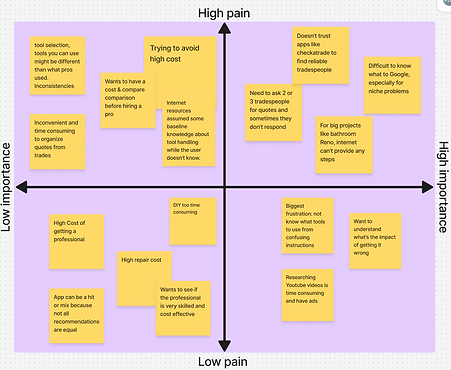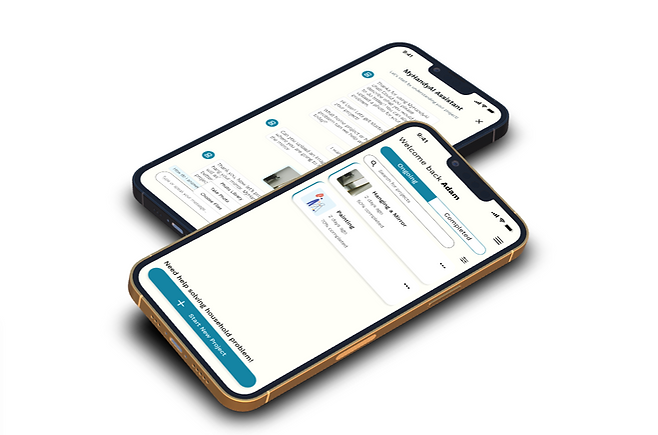myhandyai: ai-powered diy app
MyHandyAI is an AI-powered DIY app that helps guide people on DIY projects without the need of paying a handyman. I designed the experience and interface of the DIY app for their upcoming iOS & Android app.
CLIENT
MYHANDYAI
MYROLE
UX RESEARCHER & DESIGNER
TEAM
DEVELOPERS, DATA SCIENTISTS, PROJECT MANAGERS
TIMELINE
12 WEEKS IN SUMMER 2025

PROBLEM STATEMENT
Homeowners waste an average of $500+ annually on minor repairs that could easily be completed as DIY projects. Unfortunately, 70% of DIY attempts end in frustration due to lack of personalized guidance.
Our Solution? Snap. Solve. Save. MyHandyAI redefines home repair by delivering expert, personalized guidance instantly, making fixes simpler, faster, and more accessible.
MY ROLE
As part of the MyHandyAI team, I not only contributed towards the development of the user experience, including all product research, design, prototyping and team communication. I also provided iterative feedbacks with developers, designers and product managers to iterate rapidly while considering diverse perspectives in my work.
CONCEPTUALIZATION
Before approaching design, it was important to understand the problems with current other competing DIY apps out in the market. I established a baseline with a customer journey map, information architecture and user flow. Then, in order to discover user pain points I documented my findings. Finally, to ensure a competitive solution, my team and I conducted a market analysis of other apps in the DIY market.



CORE CUSTOMER'S ISSUE
In order to build the app we must first understand a potential user's pain points. My team and I outreached 30 people. 6 users participated in the interview, survey, and follow-up.
During this phase, I received crucial information on how participants interacted with specific features, which helped me identify pain points and opportunities to refine the application.
Based on the journey map and empathy insights, we created a Risks & Mitigation chart to determine 7 types of potential risk based on User's feedback. We also came up with several different mitigation strategies to mitigate the mentioned risks.


THE PERSONA
After I've figured out what the customer's pain point, risk assessment and several research in the DIY market. I created a persona that aims towards homeowners who are struggling with home repairs but is tech literate, knowledgeable about tools. Based on the research of 6 customer's pain points, I've aligned the persona's habits based on the aforementioned research and conclusions.

DESIGN
I created a list of tasks and user flows to identify edge-cases while designing. Furthermore, these flows grounded the solution in user intent. I approached my iteration of high-fidelity prototypes by making a mood board with a few icons and images of relevant, small-scale, and relevant information. I went through several different ideations and sought feedback from product engineering team and product managers to refine and creating the product.



Low-fidelity wireframes were then created and later incorporated into the DIY app, where my test participants can interact and perform tasks for the usability of this DIY app.

During this process, a four-column grid was utilized to convert the initial designs into mid-fidelity wireframes.
REFLECTION
Throughout this project, MyHandyAI successfully transformed an underused touchpoint in the customer journey. By grounding our design decisions in user research, we developed design and content solutions that directly addressed the distinct needs having a handyman DIY and AI assistance in the palm of the user's fingertips. We believe that MyHandyAI transforms how homeowners approach repairs by putting expert knowledge at their fingertips through advanced AI technology.
NEXT STEPS
The success metrics established for this project will continue to inform iterative improvements, ensuring the buyer's guide evolves with changing customer needs. The research methodologies, personas, and design principles developed during this project also provide a replicable framework for enhancing other customer touchpoints across the MyHandyAI experience.
This case study exemplifies how thoughtful UX research and design can transform business constraints into opportunities for meaningful customer experience improvements.
Let's Work Together!
If you have a project in mind, or would like to chat, shoot me an email at
xiongjin631@gmail.com. I'd love to hear from you.


